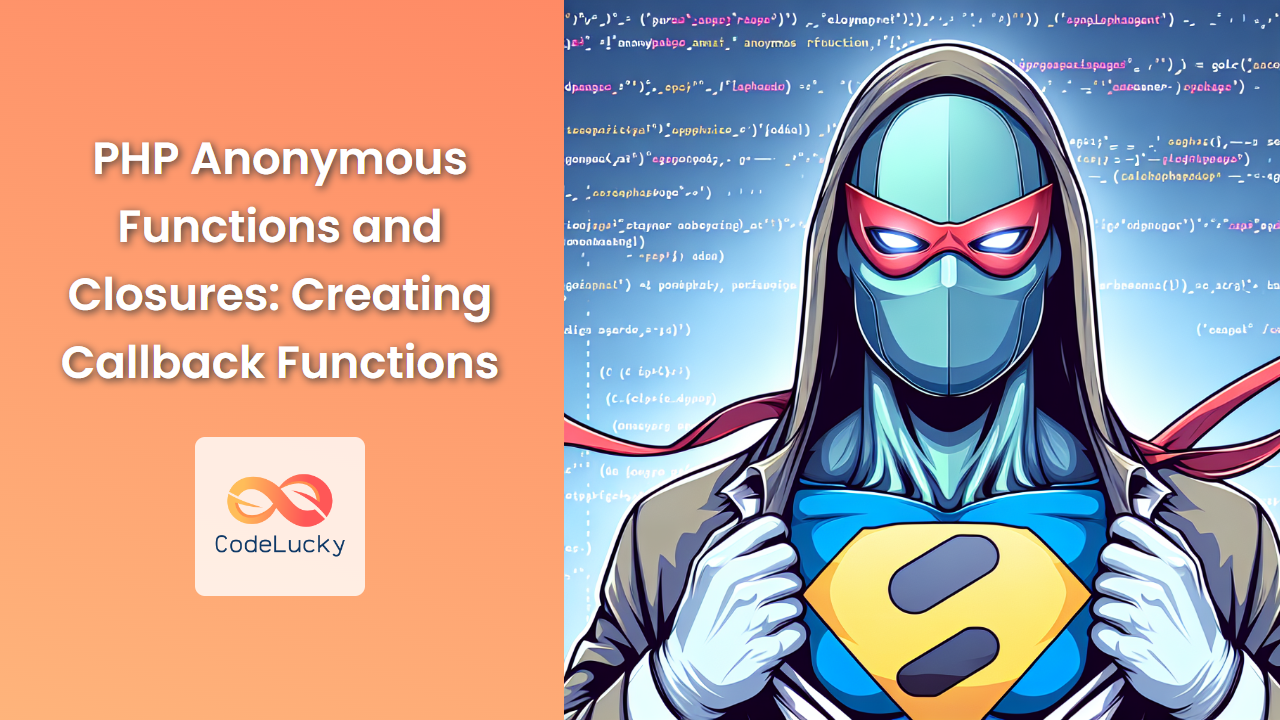In the world of PHP programming, anonymous functions and closures are powerful tools that can significantly enhance your code's flexibility and readability. These features, introduced in PHP 5.3, allow developers to create functions on the fly and use them as callback functions. In this comprehensive guide, we'll dive deep into the world of anonymous functions and closures in PHP, exploring their syntax, use cases, and best practices.
Understanding Anonymous Functions
Anonymous functions, also known as lambda functions, are functions without a specified name. They are particularly useful when you need a simple function for a limited purpose. Let's start with a basic example:
$greet = function($name) {
return "Hello, $name!";
};
echo $greet("Alice"); // Output: Hello, Alice!
In this example, we've created an anonymous function and assigned it to the variable $greet. We can then call this function using the variable name.
🔍 Key Point: Anonymous functions are treated as objects of the Closure class in PHP.
Using Anonymous Functions as Callbacks
One of the most common use cases for anonymous functions is as callbacks. Let's look at an example using the array_map() function:
$numbers = [1, 2, 3, 4, 5];
$squared = array_map(function($n) {
return $n * $n;
}, $numbers);
print_r($squared);
Output:
Array
(
[0] => 1
[1] => 4
[2] => 9
[3] => 16
[4] => 25
)
Here, we've used an anonymous function as a callback to square each number in the array. This approach is much cleaner than defining a separate named function for this simple operation.
Closures: Capturing the Surrounding Scope
Closures are anonymous functions that can capture variables from the surrounding scope. This feature allows for powerful and flexible programming patterns. Let's see an example:
function createMultiplier($factor) {
return function($number) use ($factor) {
return $number * $factor;
};
}
$double = createMultiplier(2);
$triple = createMultiplier(3);
echo $double(5); // Output: 10
echo $triple(5); // Output: 15
In this example, the createMultiplier function returns a closure that "remembers" the $factor value. This allows us to create specialized multiplier functions on the fly.
🌟 Pro Tip: Use closures when you need to create functions that maintain state between calls.
Passing Variables by Reference
By default, closures capture variables by value. However, you can capture variables by reference using the & symbol:
$message = "Hello";
$greet = function() use (&$message) {
$message .= ", World!";
};
$greet();
echo $message; // Output: Hello, World!
In this case, the closure modifies the original $message variable, not a copy.
Anonymous Functions as Object Methods
Anonymous functions can also be used as object methods. Here's an example:
class Greeter {
public $greeting = "Hello";
public function greet() {
return function($name) {
return "{$this->greeting}, $name!";
};
}
}
$greeter = new Greeter();
$greetFunc = $greeter->greet();
echo $greetFunc("Bob"); // Output: Hello, Bob!
In this case, the anonymous function can access the object's properties using $this.
Using Closures for Memoization
Closures are excellent for implementing memoization, a technique used to speed up programs by caching expensive function call results. Here's an example:
function memoize($func) {
return function() use ($func) {
static $cache = [];
$args = func_get_args();
$key = serialize($args);
if (!isset($cache[$key])) {
$cache[$key] = call_user_func_array($func, $args);
}
return $cache[$key];
};
}
$fibonacci = memoize(function($n) use (&$fibonacci) {
if ($n < 2) return $n;
return $fibonacci($n - 1) + $fibonacci($n - 2);
});
echo $fibonacci(30); // Output: 832040 (calculated quickly due to memoization)
This example demonstrates a memoized version of the Fibonacci sequence calculator, which significantly improves performance for repeated calculations.
Arrow Functions: Shorthand Syntax
PHP 7.4 introduced arrow functions, a shorthand syntax for simple anonymous functions:
$numbers = [1, 2, 3, 4, 5];
$squared = array_map(fn($n) => $n * $n, $numbers);
print_r($squared);
Arrow functions automatically capture variables from the parent scope, making them more concise for simple operations.
Best Practices and Considerations
-
Readability: While anonymous functions can make code more concise, overusing them can harm readability. Use them judiciously.
-
Performance: Creating closures has a small performance overhead. For performance-critical code, consider using regular functions.
-
Debugging: Anonymous functions can make stack traces harder to read. Consider using named functions for complex operations.
-
Serialization: Closures cannot be serialized. If you need to store or transmit functions, use named functions instead.
-
Scope: Be mindful of the variables you capture in closures, especially when using references, to avoid unexpected side effects.
Conclusion
Anonymous functions and closures are powerful features in PHP that enable more flexible and expressive code. They're particularly useful for callbacks, creating specialized functions on the fly, and implementing advanced programming patterns like memoization. By understanding these concepts and following best practices, you can write more efficient and maintainable PHP code.
Remember, the key to mastering anonymous functions and closures is practice. Experiment with different scenarios, and you'll soon find yourself reaching for these tools naturally when solving complex programming challenges.
🚀 Challenge: Try implementing a simple event system using closures as event handlers. This exercise will help solidify your understanding of how closures can be used in real-world applications.
Happy coding, and may your PHP journey be filled with anonymous functions and closures that make your code shine! 🌟



















